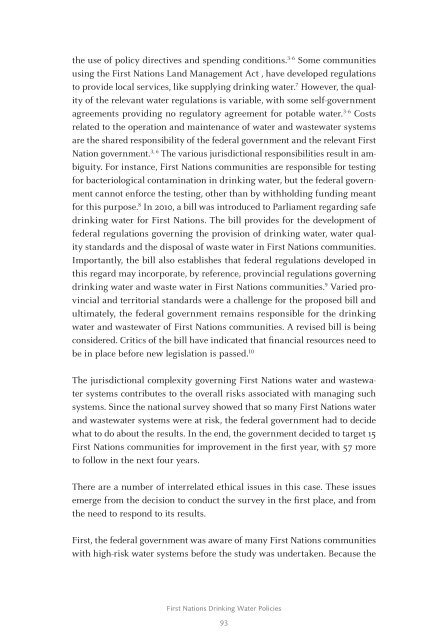PoPulationand Public HealtH etHics
PoPulationand Public HealtH etHics
PoPulationand Public HealtH etHics
You also want an ePaper? Increase the reach of your titles
YUMPU automatically turns print PDFs into web optimized ePapers that Google loves.
the use of policy directives and spending conditions. 3-6 Some communities<br />
using the First Nations Land Management Act , have developed regulations<br />
to provide local services, like supplying drinking water. 7 However, the quality<br />
of the relevant water regulations is variable, with some self-government<br />
agreements providing no regulatory agreement for potable water. 3-6 Costs<br />
related to the operation and maintenance of water and wastewater systems<br />
are the shared responsibility of the federal government and the relevant First<br />
Nation government. 3, 6 The various jurisdictional responsibilities result in ambiguity.<br />
For instance, First Nations communities are responsible for testing<br />
for bacteriological contamination in drinking water, but the federal government<br />
cannot enforce the testing, other than by withholding funding meant<br />
for this purpose. 8 In 2010, a bill was introduced to Parliament regarding safe<br />
drinking water for First Nations. The bill provides for the development of<br />
federal regulations governing the provision of drinking water, water quality<br />
standards and the disposal of waste water in First Nations communities.<br />
Importantly, the bill also establishes that federal regulations developed in<br />
this regard may incorporate, by reference, provincial regulations governing<br />
drinking water and waste water in First Nations communities. 9 Varied provincial<br />
and territorial standards were a challenge for the proposed bill and<br />
ultimately, the federal government remains responsible for the drinking<br />
water and wastewater of First Nations communities. A revised bill is being<br />
considered. Critics of the bill have indicated that financial resources need to<br />
be in place before new legislation is passed. 10<br />
The jurisdictional complexity governing First Nations water and wastewater<br />
systems contributes to the overall risks associated with managing such<br />
systems. Since the national survey showed that so many First Nations water<br />
and wastewater systems were at risk, the federal government had to decide<br />
what to do about the results. In the end, the government decided to target 15<br />
First Nations communities for improvement in the first year, with 57 more<br />
to follow in the next four years.<br />
There are a number of interrelated ethical issues in this case. These issues<br />
emerge from the decision to conduct the survey in the first place, and from<br />
the need to respond to its results.<br />
First, the federal government was aware of many First Nations communities<br />
with high-risk water systems before the study was undertaken. Because the<br />
First Nations Drinking Water Policies<br />
93
















